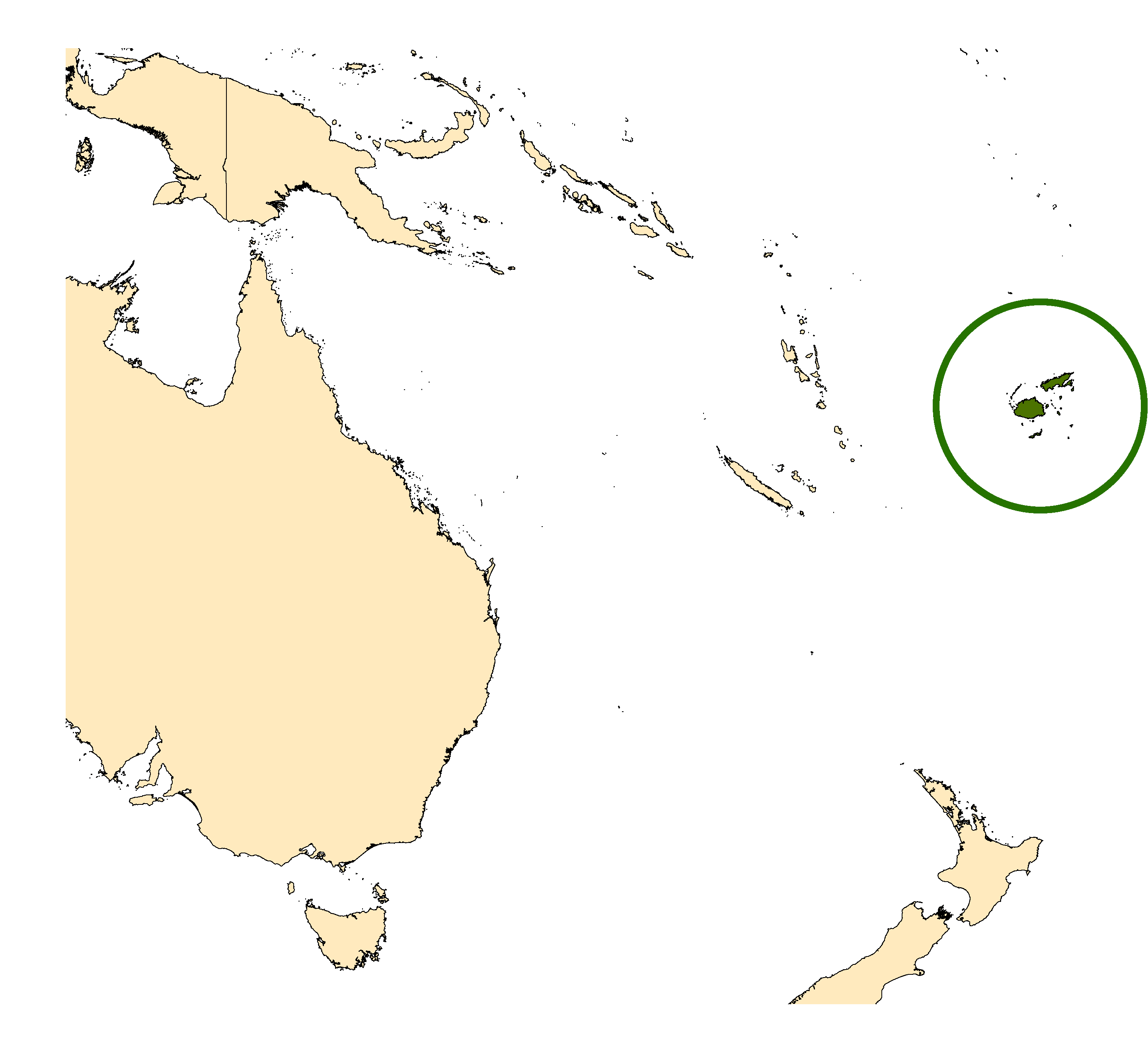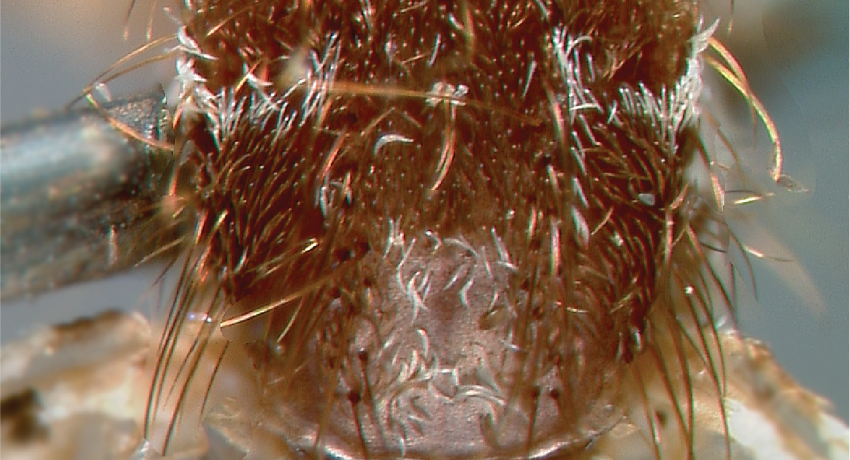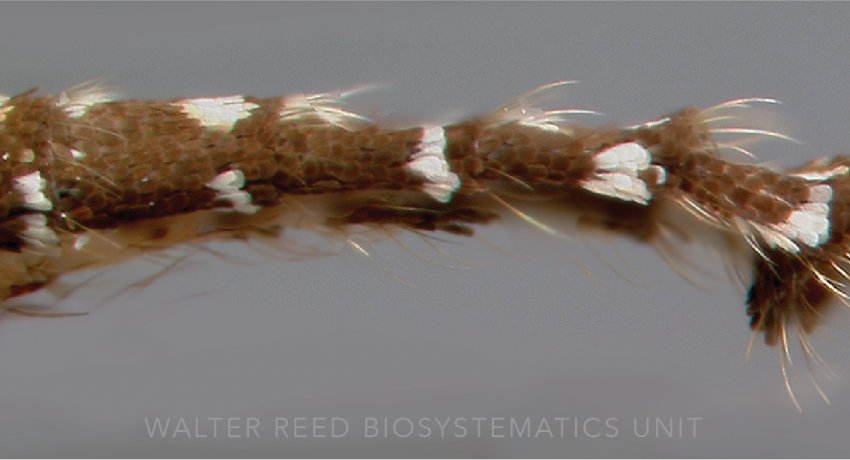PACIFIC REGION
Etymology: Fiji
Aedes fijiensis is a distinctive mosquito, with ornate multiple white leg-bands of varying thicknesses and highly decorated wings and abdomen with plentiful clusters of white scales, giving the illusion of spots. Until the description of this Fijian endemic, the species was referred to as Ae. kochi (Dönitz), the nominotypical member of the Kochi Group. As larvae, members of the Kochi Group are highly distinctive, and can be readily differentiated from other Aedes species as they bear multiple stellate setae on the thorax and abdomen, and a comb bearing ≥50 comb scales. Two other Kochi Group species are present on Fiji Ae. samoanus (Grünberg) and Ae. freycinetiae Laird, with these being more closely related to each other than to Ae. fijiensis.
Type locality: Koronivia, Viti Levu, Fiji
Type depository: U.S. National Museum, Washington, D.C., United States (USNM)
DIAGNOSTIC CHARACTERS (Click photos to view; mouse over and click large photo to zoom in.)
ADULT (illustrated): Head: Proboscis with broad median pale band. Thorax: Scutal pale scales bright white; scutellar lateral lobes scales pale, dark scales present on midlobe; halter largely dark-scaled. Wing: Regular spots of pale and dark scales; prehumeral pale spot distinct; preapical pale spot not developed on vein C. Legs: Fe-I–III and Ti-I–III with many pale spots and rings; Fe-I–III with prominent apical scale tufts; Ta-III2,3 with basal ≥ 0.5 dark; Ta-III4 all dark. Abdomen: VI,VII-S with apical tufts of erect dark scales.
LARVA (not illustrated): Head: Seta 4-C usually 2–5 branched, without enlarged base, posterior to or level with seta 6-C; seta 14-C large stellate, multi-branched. Abdominal segments: Seta 1-III–V stellate with numerous branches of same size or slightly longer as setae 2 and 3 on corresponding segments; seta 6-III–V, usually 2–3 branched; seta 12-I present; seta 13-II–V usually ≥4 branched. Terminal segments: Comb with ≥ 50 comb scales in triangular patch; distal row of CS with 2–4 lateral spinules and fine spinules (fringe) apically; seta 1-X usually 2–3 branched; seta 4-X with 5 pairs of setae, each with long basal stalk, all arising from basal boss, without distinct bars; siphon with uniform, dense short spicules.
TAXONOMIC KEYS
Huang 1977c
Lee et al. 1988a
![]()
WRBU – Aedes – Australasian Region – Larva
Exemplar DNA sequences
None
BIONOMICS
Immatures
Typical immature habitats for Aedes fijiensis are in water collections in the leaf axils of coastal Pandanus tectorius (Sol.) (screw palm). Screw palms are farmed for fiber and the taro roots are a valuable food source in the Tropics, placing the developmental sites for this species close to people. Immatures have also been collected in the leaf axils of the smaller Pandanus thurstonii Wright, and from the aroid Alocasia indica.
Adults
Although endemic to the islands of Fiji, Ae. fijiensis is an aggressive anthrophophilic pest species. It bites at night, and serves as a highly effective of vector of filariasis in Fiji. Females rest both in homes and in the forest. In one study, 21.6% of all Ae. fijiensis caught were found to be positive for filaria, mostly Wuchereria bancrofti.
DISTRIBUTION NOTES
Fiji

WRBU VECTOR HAZARD REPORTS
None; View other WRBU Vector Hazard Reports
Available GIS Models:
None
IMPORTANT REFERENCES (full citations below)
Paine 1943 (bionomics)
Amos 1947 (bionomics, distribution)
Symes 1955 (bionomics, medical importance)
Laird 1957 (taxonomy, bionomics; systematics Kochi Gp)
Belkin 1962: 308 (M*, F, P*, L*; Mansonia)
Huang 1977c (F*, L*; keys, distr.)
Lee et al. 1988a: 88 (F key, taxonomy, bionomics, distribution, review)
CURRENT SYNONYMS
None
CITED REFERENCES
Amos, D.W. (1947). Mosquito Control Training Manual. Government Press. Suva, Fiji. pp. 1-44.
Belkin, J.N. (1962). The mosquitoes of the South Pacific (Diptera, Culicidae) (Vols. 1 & 2). Berkeley, California: University of California Press.
Huang, Y.-M. (1977c). The mosquitoes of Polynesia with a pictorial key to some species associated with filariasis and/or dengue fever. Mosquito Systematics, 9(3), 289–322.
Laird, M. (1957). A new mosquito from Fiji, Aedes (Finlaya) freycinetiae n. sp. (Diptera: Culicidae). Pacific Science, 11, 342–351.
Lee, D.J., Hicks, M.M., Griffiths, M., Debenham, M.L., Bryan, J.H., Russell, R.C., . . . Marks, E.N. (1988a). The Culicidae of the Australasian region. Volume 6. Commonwealth Department of Health, School of Public Health and Tropical Medicine Monograph Series, 2.
Paine, R.W. (1943). An introduction to the mosquitoes of Fiji. Descriptive notes on the commoner species, their breeding places and occurrence; together with simplified keys for distinguishing the adults and larvae of Fijian mosquitoes. Bulletin of the Department of Agriculture Fiji, 22, 1–35.
Symes, C.B. (1955). Filarial infections in mosquitoes in Fiji. Transactions of the Royal Society of Tropical Medicine and Hygiene, 49, 280-282; with comments by Sir Philip Manson-Bahr, pp.282-284.
CITE THIS PAGE
Walter Reed Biosystematics Unit (Year). Aedes fijiensis species page. Walter Reed Biosystematics Unit Website, http://wrbu.si.edu/vectorspecies/mosquitoes/fijiensis, accessed on [date (e.g. 03 February 2020) when you last viewed the site].











































































































































































